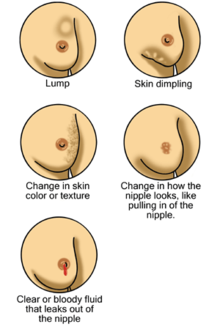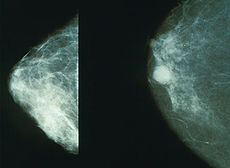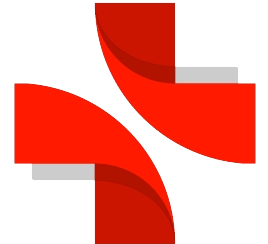What causes breast cancer?
A cancerous tumour starts from one abnormal cell. The exact reason why a cell becomes cancerous is unclear. It is thought that something damages or alters certain genes in the cell. This makes the cell abnormal and multiply out of control.
Risk factors
Although breast cancer can develop for no apparent reason, there are certain risk factors which increase the chance that breast cancer will develop. These include:
 • Age. The risk of developing breast cancer roughly doubles for every 10 years of age. Most cases develop in women over the age of 50.
• Age. The risk of developing breast cancer roughly doubles for every 10 years of age. Most cases develop in women over the age of 50.
• Where you live. The rate of breast cancer varies between countries. This may reflect genetic or environmental factors.
• Family history. This means if you have close relatives who have or have had breast cancer. In particular, if they were aged under 50 when diagnosed.
• If you have had a previous breast cancer.
• Being childless, or if you had your first child after the age of thirty.
• Not having breast-fed your children.
• Early age of starting periods.
• Chest being exposed to radiation.
• Having a menopause over the age of 55.
• Taking continuous combined hormone replacement therapy (HRT) for several years (in women over 50 years), leading to a slightly increased risk.
• Excess alcohol.
Family history and genetic testing
About 1 in 20 cases of breast cancer are caused by a faulty gene which can be inherited. The genes BRCA1 and BRCA2 are the most common faulty genes. See separate leafletBreast Cancer - Hereditary Factors for further details.
Breast cancer symptoms
The usual first symptom is a painless lump in the breast. Note: most breast lumps are notcancerous. Most breast lumps are fluid-filled cysts or fibroadenomas (a clumping of glandular tissue) which are benign. However, you should always see a doctor if a lump develops, as the breast lump may be cancerous.
Other symptoms of breast cancer
 • Changes in the size or shape of a breast.
• Changes in the size or shape of a breast.
• Dimpling or thickening of some of the skin on a part of a breast.
• The nipple becoming inverted (turning in).
• Rarely, a discharge occurring from a nipple (which may be bloodstained).
• A rare type of breast cancer, causing a rash around the nipple, which can look similar to a small patch of eczema.
• Rarely, pain in a breast. Note: pain is not a usual early symptom. Many women develop painful breasts (mastalgia) and this is not usually caused by cancer.
The first place that breast cancer usually spreads to is the lymph glands (nodes) in the armpit (axilla). If this occurs, you may develop a swelling or lump in an armpit. If the cancer spreads to other parts of the body then various other symptoms can develop.
How is breast cancer diagnosed?
Initial assessment
If you develop a lump or symptoms which may be breast cancer, a doctor will usually examine your breasts and armpits to look for any lumps or other changes. You will normally be referred to a specialist. Sometimes a biopsy of an obvious lump (see below) is arranged, but other tests may be done first such as:
• Mammogram. This is a special X-ray of the breast tissue.
• Ultrasound scan of the breast.
• MRI scan of the breast. This is more commonly performed on younger women, who may have denser breast tissue.




